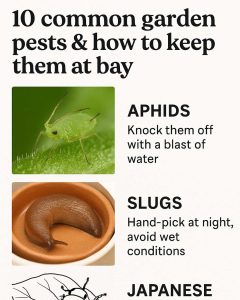Gardening is a fulfilling and therapeutic hobby that not only adds beauty to your surroundings but also brings a sense of accomplishment. However, every gardener knows that maintaining a healthy garden comes with its share of challenges, especially when it comes to dealing with pests. From tiny bugs to larger, more destructive creatures, garden pests can wreak havoc on your plants if left unchecked. To keep your garden thriving, it’s essential to identify and manage these pests effectively. In this guide, we’ll explore ten of the most common garden pests and share practical, natural solutions to help you deal with them without harming the environment or beneficial insects.

Aphids are among the most common and damaging pests in any garden. These small, soft-bodied insects can be green, black, brown, or pink and often gather on the undersides of leaves. They feed by sucking sap from the plant, which can cause leaves to curl, yellow, or fall off. Because aphids reproduce rapidly—females can give birth to as many as 80 offspring in a single week—a small problem can turn into a major infestation in no time. In addition to stunted growth and poor harvests, aphids also excrete a sticky substance called honeydew, which attracts ants and can lead to the growth of sooty mold, further damaging your plants and reducing their ability to photosynthesize.
To fight off aphids without using chemicals, a simple dish soap solution works wonders. Mix one tablespoon of mild liquid dish soap with a quart of water in a spray bottle. Spray this mixture directly onto the leaves, especially the undersides where aphids cluster. The soap dissolves the protective outer layer of the aphids, dehydrating and killing them. Be sure to use a gentle soap to avoid harming your plants, and repeat the process every few days until the aphids are gone.
Slugs are another common garden pest, particularly active at night and during damp conditions. They leave behind large, irregular holes in leaves and can severely damage young, tender plants. You can recognize their presence by the shiny, slimy trails they leave behind. Slugs tend to hide in mulch, under boards, or among garden debris during the day. To discourage them, try watering your garden in the morning rather than at night and keep the area tidy by removing hiding spots like decaying leaves or mulch layers.
One of the most effective and eco-friendly ways to deal with slugs is using beer traps. Take a shallow container like a plastic cup or yogurt container and bury it in the soil so that the rim is even with the ground. Fill it with beer, which attracts slugs due to its yeast scent. They crawl in and drown. Place these traps near plants that have been targeted by slugs, and replace the beer every couple of days to keep them effective.
Japanese beetles are another menace for many gardeners. These metallic green insects with coppery wings feed on the foliage, flowers, and fruits of over 300 plant species. They often appear in groups, especially on warm, sunny days. Their feeding habit leaves behind “skeletonized” leaves, where only the veins remain, which weakens plants and leaves them vulnerable to disease. Spotting them early can help prevent large-scale damage.
One simple way to reduce their population is by handpicking. In the early morning when beetles are sluggish, gently shake or tap the affected plants. The beetles will fall off easily. Collect them in a bucket filled with soapy water to kill them. While this method requires consistency, especially during peak season, it can significantly minimize their numbers over time.
Caterpillars, the larval stage of moths and butterflies, can also be a major nuisance. These hungry feeders chew holes in leaves, stems, and fruit, often causing widespread damage before you even notice. To reduce caterpillar problems, attract natural predators like birds, ladybugs, and lacewings to your garden. You can also inspect your plants regularly and remove any caterpillars you see by hand.
For an organic treatment, try using Bacillus thuringiensis, or Bt, a naturally occurring bacterium that specifically targets caterpillars without harming other wildlife. It’s safe to use on vegetables and should be applied according to package directions for the best results.
Spider mites are tiny arachnids that are hard to spot without a magnifying glass, but their damage is easy to see—yellow-speckled leaves, webbing, and eventual leaf drop. These pests thrive in hot, dry environments. One natural way to discourage them is to increase humidity around your plants. You can also hose your plants down with a strong spray of water to knock them off.
For more persistent infestations, neem oil works well. Mix two tablespoons of neem oil with a gallon of water and apply it to your plants, making sure to coat the undersides of the leaves. Repeat every 7 to 14 days until the mites are gone.
Whiteflies, small white insects that swarm around when disturbed, feed on the undersides of leaves and cause them to yellow and wilt. They also produce honeydew, leading to mold problems. Companion planting can help reduce whitefly problems—grow marigolds, basil, or nasturtiums near plants that tend to attract whiteflies to repel them naturally.
Additionally, yellow sticky traps placed near affected plants can catch adult whiteflies, helping to monitor and reduce their population. These traps are simple to use and do not harm beneficial insects.
Snails, like slugs, chew large holes in leaves and can destroy entire seedlings overnight. One effective way to keep them away is by using copper tape as a barrier. When a snail touches copper, it experiences a mild electric shock, which deters it from crossing the barrier. Wrap copper tape around garden beds or container edges, making sure it’s at least two inches wide for maximum protection.
Finally, thrips are small, slender insects that suck the contents of plant cells, leaving behind silvery patches and distorted leaves. They can also transmit plant viruses. Neem oil is a natural and effective way to deal with thrips. Mix two tablespoons of neem oil with one gallon of water, adding a few drops of dish soap to help the mixture stick to the leaves. Spray the solution thoroughly, focusing on the undersides of leaves where thrips often hide. Reapply every 7 to 10 days until the infestation is under control.
With a little patience and the right approach, you can manage these common pests without resorting to harsh chemicals. By staying vigilant and using eco-friendly methods, you’ll keep your garden healthy, vibrant, and full of life throughout the season.





